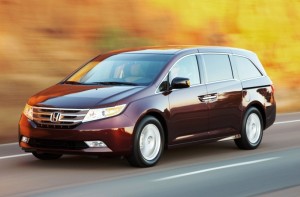They’re designed to save lives and reduce potential serious injuries, but a search of federal records reveals that a surprising number of Americans have been killed or injured due to problems with vehicle airbag systems.
In fact, defects involving the devices have been among the most common factor in the surge in safety-related recalls over the last several years. A total of 1.5 million vehicles have already been targeted by airbag recalls ordered by Honda and Toyota this year, with 22 separate recalls involving 18 different brands in 2012 involving airbag defects.
“It’s a complex system and that complexity implies more components, Honda spokesman Chris Martin told USA Today.
The maker has had some of the most serious problems with airbag defects in recent years, including a recall in January that involved nearly 750,000 Pilot and Odyssey models. Missing rivets on an airbag cover could cause the devices to fail to inflate properly, noted the maker, “increasing the risk of injury in a crash.”
While there were no injuries linked to the latest problem, Honda acknowledged that in a separate recall 14 months ago at least two deaths and 20 accidents resulted from airbags that could inflate over-aggressively. In fact, similar problems on Honda vehicles have now triggered a series of recalls involving more than 2 million vehicles.
Toyota has had problems of its own with defective airbags, including a January 2013 recalls involving nearly 900,000 Corolla and Matrix models – as well as Pontiac Vibe crossovers assembled by Toyota. That problem involved a defective circuit board that could short out and trigger the bag to inflate unexpectedly.
The list of manufacturers impacted by faulty airbags reads like an industry Who’s-Who, ranging from Hyundai to Chrysler, the latter maker recalling almost 750,000 Jeeps last November, also because of faulty airbag controller circuits.
The problems appear to fall into several categories:
- Airbag systems that deploy when they’re not needed, whether due to faulty sensor or short-circuiting control systems, or because of incorrectly programmed software;
- Airbags that fail to deploy for similar reasons;
- Airbags that may not be properly installed and can inflate too aggressively or even send shards of plastic or metal flying into the passenger compartment like shrapnel from a bomb.
Last October, however, the National Highway Traffic Safety Administration revealed yet another potential problem, calling on owners of millions of vehicles that had undergone repairs after a crash to have a dealer check to ensure they weren’t equipped with counterfeit replacement airbags. Products from more than 20 different manufacturers were cited. Meanwhile, federal law enforcement agents have staged numerous arrests, many leading back to suppliers in China.
Problems with airbags are not entirely new. More than two decades ago controversy erupted when it became clear that early bag designs would inflate so aggressively that they often injured or even killed young children and small or older adults sitting too close to the bags when they deployed.
That led to the development of so-called “smart” airbags.” Today, the systems are generally designed to detect the severity of a crash and adjust their inflation force to such things as the size and seating position of an occupant – or whether there is a child in the seat.
That has led to a substantial reduction in injuries and fatalities when the bags have worked as expected – and, according to federal safety regulators, helped save 1,000s of lives annually.
“Air bags in particular play a central role in keeping drivers and passengers safe in the event of a crash,” said Administrator David Strickland of the National Highway Traffic Safety Administration.
Despite recent problems with airbag defects, the auto industry appears intent on adding more of the devices to the typical car, and in places not previously imagined.
The new Dodge Dart, notes USA Today, has 10 different airbags. And other vehicles aren’t far behind. It’s become routine for mainstream products to be equipped with dual front airbags, side impact airbags and roof-mounted bags that can stay inflated longer in the event of a rollover.
Knee-blocker airbags are becoming more common and are intended to prevent front-seat passengers from “submarining” under their seatbelts in the event of a major frontal crash.
General Motors, meanwhile, recently added new front-center airbags to keep passengers from banging into one another in a side impact.
Ford, meanwhile, has begun offering a combination airbag/seatbelt on some products, such as the latest-generation Explorer. The technology is intended “to reduce injuries and deaths among children and the elderly, those who are particularly vulnerable to crash impact forces,” Sue Cischke, the recently retired head of safety at Ford, told TheDetroitBureau.com.
And Volvo had developed a new exterior airbag system, inflating from the base of the windshield, to reduce injuries when a pedestrian is struck by a vehicle.


Airbags are a good extra measure of protection but you can only do so much to protect people from themselves… Airbags are meant to be used as a compliment to seat belts yet we see injurey and deaths daily as a result of people failing to wear their seat belts. We even have high ranking federal elected officials seriously injured in auto accidents who failed to wear their seat belt.
As noted by Honda and others, the airbag deployment system is very critical and it’s easy to have a minute difference in manufacturing process affect the operation of the airbags. Naturally in America, the land of litigation… if there is any chance of jackpot justice, a paid lair will be all over the case like white-on-rice. We don’t hold individuals responsibile for their failure to wear seat belts, we punish the auto makers and vendor suppliers from not protecting individuals from their own reckless devices.